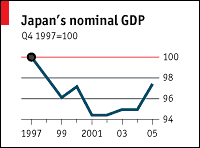
Japan's economy
Out, damned D word
The battle against
deflation seems to have been won
|
|
|
 |
|
A LOT of nasty words begin with the letter D: disease, death, devastation and danger. In comparison, deflation might seem a relatively mild affliction. Yet Japan, the first economy to suffer prolonged deflation since the 1930s, has lived with its painful economic consequences. Falling prices mean that real interest rates cannot be negative when required to reflate a sick economy. Falling prices also inflate the real burden of debt. This, in turn, depresses spending, which further intensifies deflation. And so on, in a vicious spiral.
Central bankers have long known how to fight inflation, but have been flummoxed by deflation. Five years ago the Bank of Japan launched a monetary experiment—its so-called “quantitative easing” policy, which basically means printing lots of money. The economy seems to be responding: figures last week showed that Japan's real GDP grew by 4.2% in the year to the fourth quarter (and by a stunning 5.5% annual rate in the same quarter). On that measure, it is currently the fastest-growing rich-country economy (see article).
Before declaring deflation dead, however, policy-makers need to hack through a statistical tangle. According to the Bank of Japan's preferred measure, core consumer prices (which excludes fresh food) showed a year-on-year increase (albeit only 0.1%) in November and December: two small nails in deflation's coffin. But Japan's national accountants, who compiled last week's surprising growth figures, have a more dispiriting view of deflation. By their measure, prices appeared to fall by 1.6% in the year to the last quarter: the deflationary monster is still alive and well.
In fact, both measures are flawed and give a misleading picture of what is really happening in the economy. Japan's core rate overstates inflation, because unlike in other countries, it includes energy prices, which are surging. Equally, in an economy undergoing profound structural change and suffering from deflation, it is a particularly daunting task to know how much of a change in spending is due to a change in real output, as opposed to a change in prices.
This is why the only sensible measure of Japan's economic performance is nominal GDP, ie, total national output measured in money not volume terms. When inflation is high, only changes in real output offer any sensible guidance to how the economy is performing. But in a period of deflation, nominal changes matter much more: growing real GDP means little if the economy is contracting in money terms. Between 1997 and 2004 Japan's nominal GDP shrank by 5%, while America's spurted by 42%. The good news is that in the year to the fourth quarter of 2005 Japan's nominal GDP grew by 2.6%, its fastest annual growth for almost nine years. (Even so, nominal GDP still remains below its level in 1997.)
Shrinking nominal GDP created a vicious circle by causing Japan's huge ratio of government-debt-to-GDP to rise further. Rising nominal GDP will now help to reduce that, and by boosting tax revenues it will slim the budget deficit. Faster nominal GDP growth also means that zero interest rates become more reflationary, since the gap between interest rates and nominal GDP growth is a good gauge of the tightness of monetary policy.
This underlines a big difference between today and August 2000 when the Bank of Japan briefly and prematurely abandoned its zero interest-rate policy. Real GDP growth was then running at an apparently healthy 2.5%, but nominal GDP was barely growing. Soon after the bank raised interest rates, deflation intensified and real GDP growth slowed sharply again. The Bank will be more cautious about raising rates this time, but sooner or later it will need to withdraw its unprecedented injection of liquidity if it is to prevent a future asset bubble. As Japan's economy becomes more normal, it is natural to expect a more conventional monetary policy. In economics, a bit more normalcy can be a jolly good thing.
|
|
|
|
|
Copyright © 2006 The Economist Newspaper and The Economist Group. All rights
reserved. |